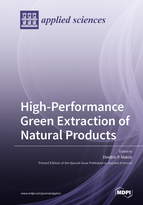High-Performance Green Extraction of Natural Products
A special issue of Applied Sciences (ISSN 2076-3417). This special issue belongs to the section "Chemical and Molecular Sciences".
Deadline for manuscript submissions: closed (30 September 2020) | Viewed by 26268
Special Issue Editor
Interests: antioxidants; biorefinery; food waste valorization; green processes; polyphenols
Special Issues, Collections and Topics in MDPI journals
Special Issue Information
Dear Colleagues,
I’m delighted to let you know that a new special issue is to be launched, entitled “High-performance Green Extraction of Natural Products”
There is to-date a large number of studies pertaining to the exploitation of plant resources (herbs, botanicals, processing by-products) for the production of extracts enriched in bioactive substances. The interest has been focused on the development of efficient and cost-effective downstream processes, which aim at producing commodities on the basis of either crude or purified extracts.
Traditional extraction techniques, including percolation, decoction/infusion generation, maceration, etc, are currently been replaced by cutting-edge, sophisticated technologies with higher efficiency and selectivity, and a more eco-friendly profile. Advanced extraction methodologies based on ultrasonication, microwaves, pulsed electric fields, high voltage discharges, enzymes, pressurized liquids, supercritical fluids etc., have in many instanced been proven more targeted, high-performing, straight-forward, fast, sustainable, fully automated and with relatively low capital cost.
This Special Issue addresses the concept of innovative and emerging strategies that aim at effectively implementing green technologies for the extraction of bioactive compounds from plant resources. Contributions pertaining to novel solvents, investigation of their properties, sustainable production of isolated bioactive compounds or whole extracts, and their utilization in the food, cosmetic or pharmaceutical industries are particularly welcome.
Dr. Dimitris P. Makris
Guest Editor
Manuscript Submission Information
Manuscripts should be submitted online at www.mdpi.com by registering and logging in to this website. Once you are registered, click here to go to the submission form. Manuscripts can be submitted until the deadline. All submissions that pass pre-check are peer-reviewed. Accepted papers will be published continuously in the journal (as soon as accepted) and will be listed together on the special issue website. Research articles, review articles as well as short communications are invited. For planned papers, a title and short abstract (about 100 words) can be sent to the Editorial Office for announcement on this website.
Submitted manuscripts should not have been published previously, nor be under consideration for publication elsewhere (except conference proceedings papers). All manuscripts are thoroughly refereed through a single-blind peer-review process. A guide for authors and other relevant information for submission of manuscripts is available on the Instructions for Authors page. Applied Sciences is an international peer-reviewed open access semimonthly journal published by MDPI.
Please visit the Instructions for Authors page before submitting a manuscript. The Article Processing Charge (APC) for publication in this open access journal is 2400 CHF (Swiss Francs). Submitted papers should be well formatted and use good English. Authors may use MDPI's English editing service prior to publication or during author revisions.
Keywords
- green extraction
- natural products
- phytochemicals
- sustainable production






